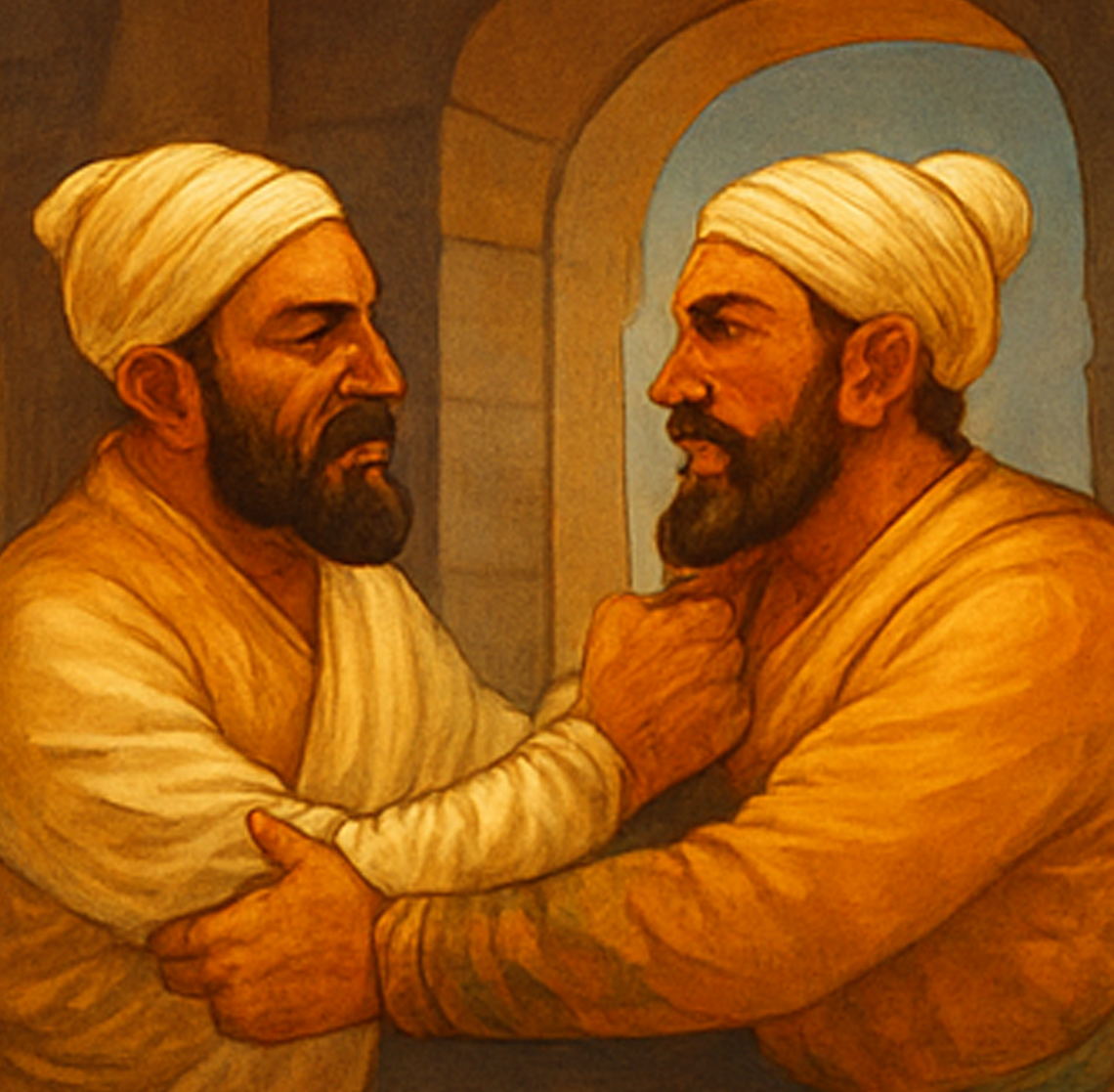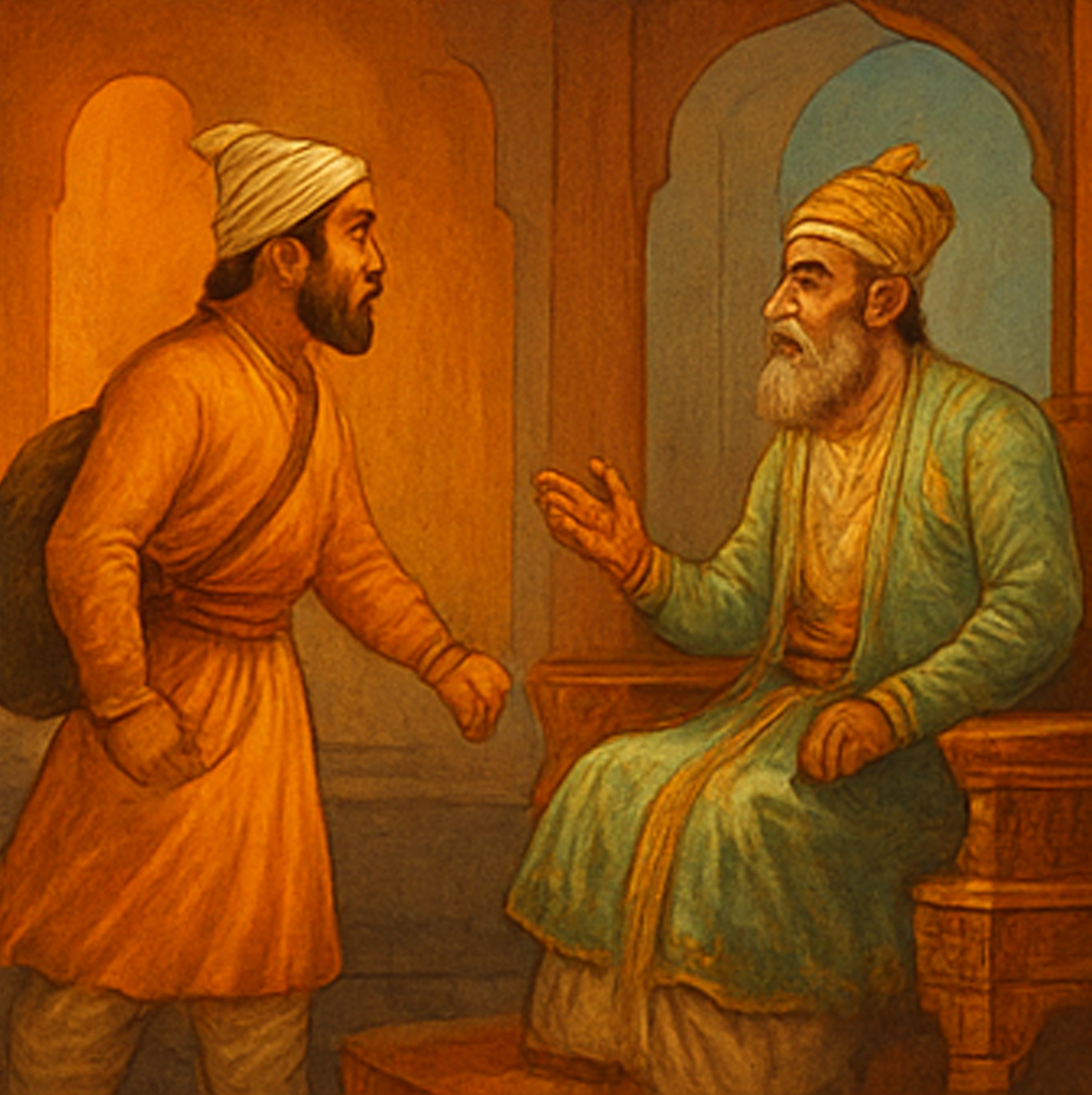Chhatrapati Shivaji Maharaj: 10 Brave Stories for Kids
Discover the courage, wisdom, and adventures of the great Maratha warrior!
1. Young Shivaji and the Seeds of Swaraj
In the quiet hills of Shivneri Fort, where young Shivaji spent his childhood, his mother Jijabai would light the lamp of knowledge in his heart every evening. She narrated tales from the Ramayana and Mahabharata, particularly emphasizing how Lord Rama established the ideal kingdom of Ayodhya. One monsoon evening, as rain pattered against the fort walls, 8-year-old Shivaji noticed farmers being harassed by oppressive tax collectors. "Why must our people suffer?" he asked his mother. Jijabai explained about foreign rulers exploiting their land. That night, Shivaji couldn't sleep. He took his toy soldiers and built a small fort from mud, declaring to his friend Netaji Palkar, "One day, I'll build real forts to protect our people!" This childhood resolve would blossom into his lifelong mission for Swaraj (self-rule). His early lessons in justice, warfare from his father Shahaji, and spiritual wisdom from Guru Ramdas shaped the visionary king he would become.
Fun Fact: Shivaji's first teacher was his mother Jijabai, who taught him reading, writing, and most importantly - the values of courage and compassion!
2. The Daring Capture of Torna Fort
The year was 1646, and 16-year-old Shivaji had been meticulously planning his first major military operation for months. Torna Fort, perched 1,403 meters above sea level, was considered impregnable by the Bijapur Sultanate. Shivaji disguised himself as a merchant and visited villages near the fort, learning from local shepherds about a hidden eastern approach guarded by just two sleepy sentries at night. On a moonless night in July, Shivaji led 200 Maval infantry through this treacherous path. They moved silently like shadows, using cloth-wrapped feet to muffle sounds. When a guard almost spotted them, Shivaji imitated a jackal's cry to distract him! Once inside, they surprised the 50-strong garrison. Rather than slaughter them, Shivaji offered the soldiers a choice: join his vision of Swaraj or leave peacefully. Over half joined him! The treasure found - including 200 mounds (about 3,200 kg) of gold - was used not for personal wealth but to strengthen defenses. This victory marked the physical beginning of the Maratha Empire and demonstrated Shivaji's brilliant military mind, compassionate leadership, and strategic use of terrain that would become his trademark.
Did You Know? Torna was just the first of about 300 forts Shivaji would capture or build during his lifetime!
3. The Deadly Game with Afzal Khan
In 1659, the monstrous Afzal Khan - standing 7 feet tall with a reputation for crushing rebels' skulls with his bare hands - was sent to destroy Shivaji. Knowing direct combat would be suicidal, Shivaji prepared meticulously. He secretly trained for months in a special wrestling style called "Mardani Kusti" to counter Khan's strength. When Khan proposed a "peace meeting" at Pratapgad Fort, Shivaji anticipated treachery. He wore armor beneath his clothes, concealed a metal tiger claw (bagh nakh) in his right hand, and had a thin dagger (bichwa) in his left sleeve. The meeting under a canopy turned deadly when Khan suddenly crushed Shivaji in a bear hug while drawing his dagger. Shivaji's armor saved him from the initial attack, and he retaliated by tearing open Khan's belly with the tiger claws. As Khan's bodyguards attacked, hidden Maratha soldiers emerged from the forest where they'd been waiting. This brilliant counter-ambush became legendary, proving Shivaji's ability to outthink physically stronger opponents. The victory established him as a major power in Deccan politics.
Historical Note: The original bagh nakh used by Shivaji is preserved at the London Museum!
4. The Great Escape from Panhala Fort
In 1660, Shivaji found himself trapped in Panhala Fort by Siddi Jauhar's massive Bijapuri army. The siege lasted five grueling months, with food supplies running dangerously low. Shivaji devised an ingenious escape plan during the monsoon season. On a stormy August night, he sent a fake messenger surrendering to Siddi Jauhar while preparing his real escape. He selected 600 elite soldiers and dressed them identically to himself to confuse the enemy. As thunder masked their movements, they used ropes to descend the fort's western cliffs - the steepest side where guards were fewest. Shivaji himself carried his sick mother Jijabai on his back during the treacherous descent. The Marathas then marched 25 km through torrential rain to Vishalgad Fort, with Baji Prabhu Deshpande and 300 soldiers making a heroic last stand at Ghod Khind (Horse Pass) to buy time. This sacrifice allowed Shivaji to reach safety and regroup his forces. The escape demonstrated Shivaji's ability to turn desperate situations to his advantage through careful planning and the loyalty of his men.
Legend Says: The spot where Baji Prabhu fell is called Pavan Khind (Sacred Pass) and is still visited by pilgrims today!
5. The Naval Vision: Building the Maratha Navy
In 1654, Shivaji made a revolutionary decision that would change Indian history - he built India's first organized navy. After witnessing Portuguese ships harassing fishermen off the Konkan coast, the 25-year-old Shivaji recognized that true Swaraj needed sea power. He recruited skilled shipbuilders from the Koli and Bhandari communities and established dockyards at Vijaydurg and Sindhudurg. His engineers designed innovative warships like the "ghurab" (floating fortresses with 400-ton capacity) and "galbat" (fast attack vessels). Shivaji personally studied tidal patterns and naval tactics, creating the post of "Sarkhel" (Admiral) for Kanhoji Angre. The navy protected trade routes, collected customs duties fairly, and prevented European colonial powers from dominating the coast. By 1670, the Maratha Navy had 200 warships and controlled 300 km of coastline. This visionary establishment of naval power 50 years before the British Royal Navy shows Shivaji's extraordinary foresight about the importance of controlling the seas.
Amazing Fact: The Sindhudurg Fort built by Shivaji has his handprint and footprint embedded in its walls!
6. The Night Attack on Shaista Khan
In April 1663, Mughal viceroy Shaista Khan occupied Pune's Lal Mahal (Shivaji's childhood home), insultingly converting its prayer room into a smoking den. For three years, Khan's army oppressed Maharashtra while Shivaji patiently waited for the right moment. On the night of April 15, during a wedding procession that provided noise cover, Shivaji led 400 Maval soldiers into Pune disguised as the bride's party. They infiltrated the heavily guarded Lal Mahal through a secret tunnel known only to local washermen. Shivaji personally burst into Khan's bedroom, swinging his famous "Bhagwa" (saffron) sword. Khan escaped by jumping through a window but lost three fingers - a humiliating injury that became legendary. The Marathas withdrew before dawn, leaving behind a mocking note: "Had you not fled like a coward, I would have presented your head to my deity Tulja Bhavani!" This daring raid forced Aurangzeb to recall Shaista Khan in disgrace and proved no Mughal was safe from Shivaji's reach. It remains one of history's most audacious special operations.
Cultural Impact: This event inspired the Maratha war cry "Har Har Mahadev!" (Victory to Lord Shiva)
7. The Surat Campaign: Striking at Mughal Wealth
In January 1664, Shivaji executed a masterstroke against Mughal economic power by raiding Surat, their richest port city. After meticulous planning with his spy network (including women agents disguised as merchants), Shivaji's 4,000 cavalry covered 400 km in just 12 days using little-known forest paths. They struck at dawn when most guards were sleeping off New Year celebrations. Rather than mindless looting, Shivaji's troops systematically targeted only Mughal treasuries and European trading houses that supported Aurangzeb, leaving local businesses untouched. The Marathas collected 10 million rupees (about $250 million today) without harming civilians - a stark contrast to typical raids of that era. When Portuguese merchants in nearby Bassein offered military aid to the Mughals, Shivaji cleverly leaked false plans suggesting he would attack them next, keeping them defensive. This operation crippled Mughal finances for years and demonstrated Shivaji's sophisticated understanding of economic warfare and psychological tactics.
Economic Impact: The Surat raid funded Shivaji's fort construction for a decade!
8. The Agra Escape: Outwitting Aurangzeb
In 1666, Aurangzeb trapped Shivaji in Agra's Diwan-i-Khas by surrounding him with 10,000 guards after insultingly placing him behind lower-ranked nobles. For three months under house arrest, Shivaji pretended illness and depression while secretly mapping escape routes. He began sending out huge baskets of sweets to temples daily - a practice the guards eventually ignored. On August 17, Shivaji and his son Sambhaji hid inside these baskets, with loyal Brahmin agents carrying them past drowsy guards during afternoon prayers. They changed disguises multiple times - as holy men, merchants, and even a beggar family - covering 800 km to safety in 30 days. The escape route involved coded messages through flower sellers, overnight stays in Dalit homes (least suspected by Mughals), and crossing the Chambal River during flash floods to erase their trail. When Aurangzeb learned of the escape, he reportedly smashed his jade cup in rage, while Maratha territories erupted in celebration for their king's miraculous return.
Strategic Genius: This escape inspired later Indian freedom fighters' evasion tactics!
9. The Coronation: Birth of Chhatrapati
On June 6, 1674, Shivaji performed his historic coronation at Raigad Fort, transforming from guerrilla leader to crowned monarch (Chhatrapati). The 14-month preparation involved: 1) Reviving ancient Vedic rituals unseen for centuries 2) Creating a new era calendar (Rajyabhisheka Shaka) 3) Designing a unique crown blending Kshatriya and local tribal traditions 4) Minting special gold coins showing Shiva's bull Nandi. The ceremony's highlight was when Gaga Bhatt, the renowned Varanasi scholar, proved Shivaji's Kshatriya lineage before skeptical priests by producing ancient copperplate records. As 50,000 subjects watched, Shivaji ascended the 7-tiered throne representing the seven sacred mountains, weighing himself against gold donated to the poor. His royal oath included revolutionary clauses: religious tolerance, women's protection during war, and banning untouchability in his court. This coronation wasn't just pageantry - it established Maratha sovereignty in the global political theater and inspired Hindu resurgence across India.
Cultural Revival: The coronation revived 32 ancient Sanskrit texts on kingship thought lost!
10. The Final Campaign: Southern Conquest
In late 1676, the 48-year-old Shivaji embarked on his last military campaign - the southern expedition (Dakshin Digvijay). Despite failing health, he recognized the strategic need to secure his empire's southern flank. The 18-month campaign covered 2,000 km through modern Karnataka and Tamil Nadu, featuring: 1) The siege of Jinjee Fort (captured using underground tunnels) 2) Naval battles against the Bijapur fleet at Karwar 3) Clever diplomacy making the Qutb Shah of Golconda his ally 4) Administrative reforms in conquered lands, appointing the first Dalit governors in Indian history. His last battle at Vellore saw innovative use of rocket artillery (the ancestor of Mysorean rockets used later against the British). Returning victorious in 1678, Shivaji collapsed from fever at Raigad. His final days were spent dictating the "Rajya Vyavahar Kosh" (a governance manual) and advising his council: "Expand not for greed, but to protect our people's freedom." His April 3, 1680 death at 52 marked the passing of India's most visionary medieval king, whose ideas of Swaraj, naval power, and compassionate rule would inspire generations.
Lasting Legacy: Shivaji's administrative system influenced the modern Indian civil service!
"Shivaji was not just a king, but a protector of the weak and a champion of justice." - Historian Jadunath Sarkar









Comments
Post a Comment